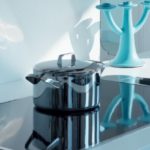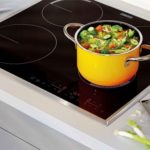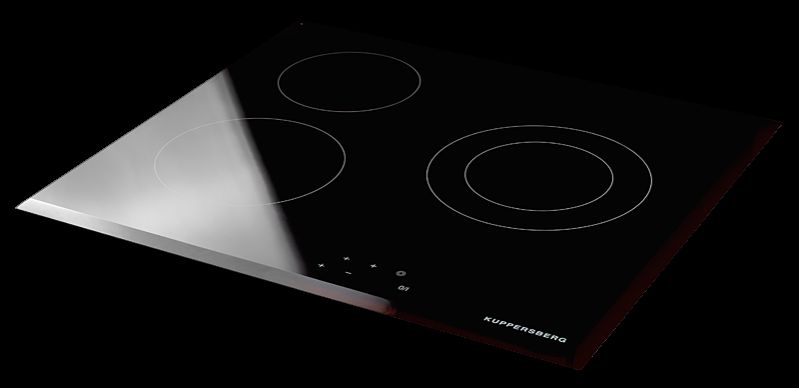How to clean a glass ceramic hob
Glass ceramic hobs have gained popularity for their attractiveness, lightness and ergonomics. They combine beauty, convenience and durability, because glass ceramics is a heat-resistant and impact-resistant material with an almost zero expansion coefficient. But this does not stop it from being glass, which is relatively easy to scratch or break with a targeted blow. Accordingly, maintenance of the hob should be regular and gentle.
The content of the article
General rules for caring for a glass ceramic hob
First and foremost, you can wash the stove only after it has completely cooled down. Disconnecting from the network would also be a good precaution - maintenance involves using water that conducts electricity well.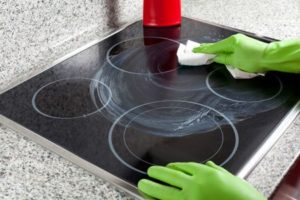
Important!Glass ceramics is a material that is very sensitive to mechanical stress. There is nothing easier than scratching the surface with the uneven bottom of a pot or pan.
To avoid such troubles, you should inspect all the dishes that will be on the stove, and mercilessly reject those with an uneven bottom.Perhaps, along the way, there will be a reason to update your kitchen arsenal and at the same time purchase more convenient and practical culinary utensils. And yes, glass ceramics do not like aluminum, so dishes made from it should also be set aside.
The following care recommendation also applies to cookware: do not place a cold, much less a wet pan on a hot surface. The outside of the cooking container must be dry, and the stove must be turned on after its installation. This is due to the fact that glass-ceramics is sensitive to sudden temperature changes - it will not burst immediately, but it will become covered with microcracks, which manifest themselves as clouding, quite quickly.
For the same reason, it is recommended to carefully select lids for dishes. If you take a “foreign” one, a large one, then droplets of condensation from it will definitely fall onto the hot stove. And this is not only a risk of damage, but also additional pollution. Limescale deposits formed during the evaporation of water are not very easy to clean off.
Important!Liquids spilled on a hot induction hob, especially sweet ones, should be removed immediately. This can be done using a metal scraper.
Do not move dishes around the stove. If you need to move something, lift it and move it. You should also avoid contact of plastic and synthetics with the hob - the molten substance is tightly glued to the surface and it is almost impossible to scrape it off later.
After all the dishes have been removed from the stove and the temperature indicator shows that the glass ceramics have cooled down, it should be wiped with a damp sponge to remove dirt. And then, to avoid streaks, wipe dry with gauze or a fiber cloth.
For these purposes, good housewives provide a separate sponge and cloth made of gauze or fiber, preferably new ones. These stove cleaning tools should not be used for anything other than cleaning the cooktop. The reason is simple: residues of detergent, drops of grease or solid particles from sponges used elsewhere will not add beauty to the stove.
How to clean a glass ceramic hob
For daily removal of light stains from tempered glass, even a window and mirror cleaner is suitable. It is sprayed onto the cooled panel and then wiped with gauze or fiber. It is acceptable to use a soap solution: apply, leave for 5 minutes and wipe dry.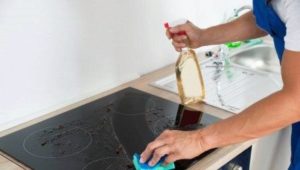
Important! The stove should be wiped regularly, after each cooking. Then it will delight its owners with its aesthetics for a long time.
But, nevertheless, it is better to purchase special products for the care of glass ceramics: the silicone they contain forms a thin film on the surface of the plate, which protects against severe contamination - oil splashes and pieces of food stick less and are much easier to clean.
Important! After using household chemicals, it is important to wash glass ceramics thoroughly with clean water. Residues from detergents when heated damage the hob.
From greasy stains
Regular dishwashing detergents do an excellent job of removing this type of stain. To do this, apply a few drops of the substance to a damp sponge, which is then used to wipe off the stain. The main thing is that after removing the grease, thoroughly clean the stove with damp gauze: residual detergent when heating the hob can seriously damage the glass ceramics.
From old carbon deposits
Such pollution is quite difficult to remove, but is not a death sentence. First, it makes sense to go the “peaceful” route:
- the hob surface is cleared and wiped with a damp sponge;
- Apply detergent to problem areas and leave there for 10–15 minutes;
- dirt is removed with gauze.
If it doesn't help – It makes sense to connect heavy artillery - a scraper. Not an ordinary one, but a special one, with replaceable blades. Carbon deposits softened by detergents are usually removed quite easily.
Important! There is no point in purchasing plastic scrapers: they can melt on a hot surface, but they are useless on a cold surface.
What not to do when cleaning a glass ceramic hob
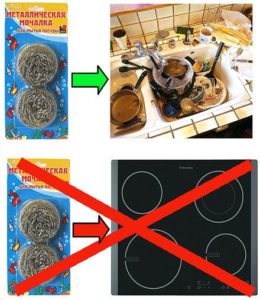 When purchasing such a stove, you should put away all abrasive cleaning products and completely forget about the possibility of using them.I'm on its plane. In addition to removing dirt, they also scratch the ceramic surface, which not only spoils its appearance, but also shortens the life of the hob.
When purchasing such a stove, you should put away all abrasive cleaning products and completely forget about the possibility of using them.I'm on its plane. In addition to removing dirt, they also scratch the ceramic surface, which not only spoils its appearance, but also shortens the life of the hob.
Metal brushes, knives and other improvised means that housewives are used to removing heavy dirt are also prohibited if you are interested in the long service life of this attractive, ergonomic, but so expensive stove. A special scraper is much cheaper.
Alkaline detergents are also not recommended - their residues when the slab is heated corrode the coating, reducing its strength.
Important! Do not polish the stove using crumpled newspapers. Microfiber or gauze are better suited for these purposes. If you moisten the material with a small amount of vegetable oil, this will create an additional layer of protection against dirt on the surface.
How to clean the hob with folk remedies
Soda - the only abrasive that can be used. But not dry, but pre-diluted with warm water to the consistency of sour cream. The resulting paste is applied to the stains and left for 15 minutes, after which the stove is cleaned with a sponge.
If this does not help, apply soda to the dirty glass surface again and leave until it partially dries. Then a few drops of lemon juice or table vinegar are dripped onto it. When the violent reaction stops, all that remains is to wash off the product and wipe the stove with gauze.
Vinegar, diluted with water in a 1:1 ratio, it copes well with limescale and greasy stains. To do this, the mixture is applied to the glass ceramics using a sprayer, left for a few minutes and then thoroughly wiped with a clean, soft material. By the way, vinegar not only cleans, but also disinfects.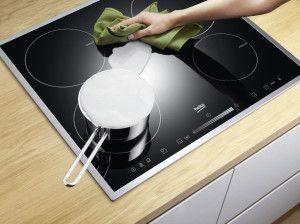
Ammonia good in the fight against burnt milk. Use it diluted in water in a ratio of 1:5 (10 g of ammonia per 50 g of water). The solution is applied to the hob and left there for 10 minutes. After the specified time, the plate is thoroughly rubbed with dry gauze. A pleasant bonus from using such a product is an extraordinary shine.
Olive oil can soften even dirt that cannot be scraped. It is enough to moisten gauze in it and apply it to the stain for half an hour. During this time, the carbon deposits will soften so much that it can be removed with an ordinary sponge.
Careful care will prevent the appearance of cracks that reduce the technical and operational characteristics of the device. This means that in the future it will be easier to remove contamination and the equipment will last longer.Therefore, it is worth reading the operating instructions for the device: usually the manufacturer gives recommendations regarding the safe removal of scale, grease stains and other types of contaminants.
Well, a reminder for housewives: vigilance is important in the kitchen. For a careful and attentive cook, a glass-ceramic hob will last much longer. After all, regularly spilled soup, splashing oil or “running” milk, which shorten the service life of equipment, are phenomena that are better and easier to prevent than to clean up later.

